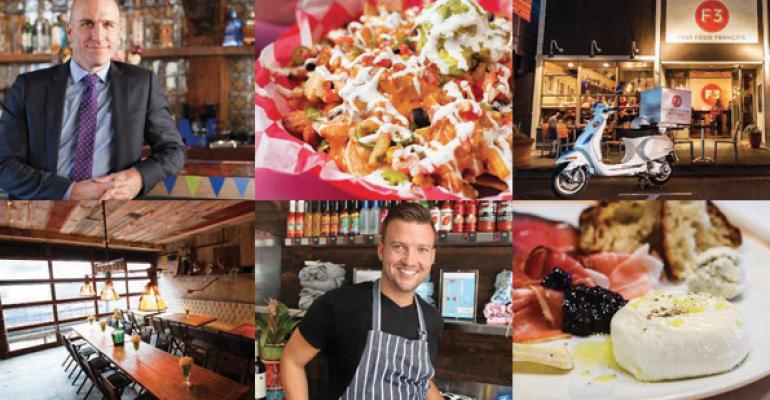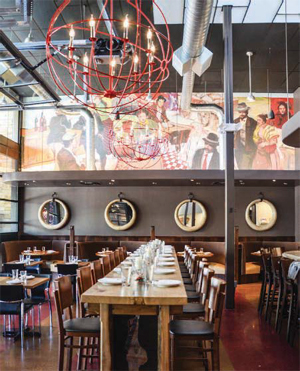
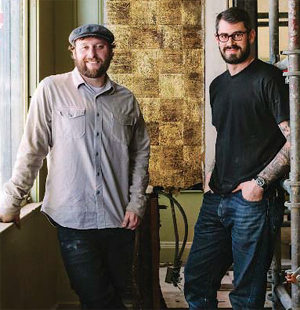
White tablecloths create a reputation, but burgers and beers pay the mortgage and college tuition. That’s the oversimplified take on the wave of prominent chefs and owners breaking away from fine dining in favor of more relaxed, less refined spinoffs. That, and the fact that more restaurant guests crave high-quality food without the high price tag and formality. The result has been an outpouring of inspired concepts.
Typical of today’s enthusiasm for casual dining is Frank Bonanno, whose Bonanno Concepts operates 10 venues in Colorado. Bonanno won widespread kudos for his first restaurant, the elegant Mizuna, when it opened in 2001. Since then he has embraced ever-more casual eateries. Bonanno’s most recent openings include Vesper Lounge (cocktails on tap, bar food), open just over a year, and Bonanno Brothers Pizzeria (wood-fired pizzas, salumi, craft beer, wines on tap), which debuted last April. His next project is Salt & Grinder, an Italian deli/salumeria set to open this month.
Bonanno is matter-of-fact about his conversion to casual. “Casual concepts cost less to operate and you’re able to take more to the bottom line,” he says. “Everything, down to the small ware, maintenance and labor, costs less, and we’re able to do more covers most of the time.”
Like many operators, the owners of Haven, a modern upscale gastrolounge in Miami Beach, figured the neighborhood needed more options for the locals. “We saw an opportunity to do a fast casual concept because there was a segment missing here,” says Niloy Thakkar, one of the owners. “I spent a lot of time in Austin, and my business partner lived in Atlanta, and we used to eat tacos for breakfast, lunch and dinner. We saw an opportunity.” When a spot opened nearby, Haven’s customers were surveyed, and the decision was made to open what became Huahua’s Taqueria. Haven executive chef Todd Erickson devised a menu with choices like fried chicken with cornbread crumbles and ancho-ranch dressing, or breakfast tacos with carnitas and fried egg. Tacos run under $4 and burritos average $9. Huahua is open at noon and closes at 11 during the week, 4 a.m. on weekends.
A lot of thought went into the design, menu and hiring for Huahua, Thakkar says. “We wanted to make sure it was a friendly, warm place where people could feel at home and stop in three or four times a week.” He sees potential for additional locations.
Bobo Ivan and Vittorio Viotti put their names on the Los Angeles landscape with the much-lauded Piccolo in Venice, but they adopted a more relaxed tone designed to capture the neighborhood’s youthful energy at Hostaria del Piccolo, which has units in Venice and nearby Santa Monica. Ivan describes the menu of antipasti, pastas, pizzas and roasted meats as comfort Italian food, dishes someone can eat every day, in reasonable portions. “Our motto is ‘eat less, taste more,’” Ivan says, an approach that runs counter to the abbondanza mentality that prevails at Italian eateries in the U.S. Ivan isn’t stinting on quality, but smaller portion sizes keep food costs low enough to justify lower price points. As a result, dinner checks average about $100 at Piccolo, closer to $40 at Hostaria.
“There’s a difference between the price of a Hyundai and a Mercedes for very specific reasons,” Ivan says. “People want to know the food is better, but at a decent price.”
When a spot opened near the Santa Monica Hostaria, Ivan and Viotti seized the opportunity to push the casual envelope a bit further. The back of the space serves as an office for their company, while the front ended up being perfect for an Italian deli, CiBOTECA. “We can serve and sell what others don’t—something new, lighter, fresher, balanced,” Ivan says. Rounding out selections are soups, salads, appetizers, desserts, coffee, prepared dishes to take home, grab-and-go items and wines. A 20-seat circular counter faces an open kitchen.
“Bobo and I have always been inspired by our Italian roots,” says Viotti. “When creating CiBOTECA, we found a need in our community for the feel of local markets in Italy that were omnipresent in our youth, offering a unique well-crafted prosciutto to one family and housemade eggplant parmigiana to another.”
Extended reach
WHAT DEFINES CASUAL?
• “Generally I feel like casual restaurants are places you can take your family and friends and not worry too much about dress code or committing time to an involved dining experience.”
—Frank Bonanno, Bonanno Concepts
• “The food quality has to be very strong, the guests have to feel like it’s a nice break and the atmosphere has to be warm and hospitable.”
—Niloy Thakkar, Haven Hospitality Concepts
• “It needs to be fun, the kind of place you can take a date or go with coworkers.”
—Teague Moriarty, partner, Sons & Daughters/Sweet Woodruff/The Square
• “Reasonably priced food, a laid-back atmosphere, vibrant décor and an energetic bar scene that injects itself into the dining room.”
—Bruno Denis, F3/Fast Food Francais
• “The menu needs to be very approachable and hit that sweet spot in price.”
—Brian Sirhal, Taqueria Feliz
• “To be sustainable going forward, you really have to have an identity. You need an approach to food that is differentiated and that people understand at the same time. It’s also important that you articulate this to the staff, get them to own it and get that experience across to the guest.”
—Tom Dillon, Rosa Mexicano
Teague Moriarty and Matt McNamara, who four years ago launched Sons & Daughters in San Francisco to great acclaim, were quick to figure out that a tiny, edgy, pricy restaurant with a fixed tasting menu was a great idea—with a very narrow potential audience. So the duo started exploring other avenues for their cooking style, which relies heavily on technique and local products. Two years ago they opened a sandwich shop called Sweet Woodruff that provides a limited all-day menu, counter service and takeout. “We had success right away,” Moriarty says, pulling in a steady stream of lower Nob Hill neighborhood regulars. The next project is The Square, a much larger space in the city’s vibrant North Beach neighborhood. It will have a full bar, a full menu of shareable items and entrees—even a burger—and 70 seats.
“The design was a really big thing for us,” Moriarty says. “We come from Sons & Daughters, our fine dining, artsy restaurant, and we knew we had to get out of that mode. We had to think ‘how can we make this place feel like a party every night?’ It needs to be fun, the kind of place you can take a take a date or go with coworkers.” Like many owners of chef-driven restaurants, Moriarty says ultimately he and McNamara were looking to create a place where they would feel comfortable. “After running a fine dining restaurant with a tasting menu for four years, I rarely if ever want to eat in one, except maybe to have a drink,” he says.
Graham Elliott closed one door and opened a decidedly less formal one recently when he shuttered his eponymous and revered Chicago restaurant (now being revamped and relocated) and debuted Primary Food & Drink in Greenwich, CT. The staff are clad in plaid shirts and smock-like aprons, guests eat from mismatched ceramic plates and choose from Elliott’s takes on comfort classics like Caesar salad, pot roast, beef stroganoff and Buffalo chicken.
“Restaurants with Michelin stars really cater to a small clientele and the way things are going, they can’t be big restaurants,” says Merlin Verrier, Primary’s executive chef and managing partner. “This makes more sense now.”
Not everybody gets what Primary Food & Drink is trying to do, at least not right away, and it probably doesn’t help that Elliott is less of a household name than he is in Chicago. “Our goal is to get people to trust us and make food choices they wouldn’t normally make,” Verrier says. “The younger demographic is very appreciative of what we are doing, because they don’t have many options for the kind of experience we offer.”
Checks at Primary average $75 a person, which doesn’t exactly shout “casual,” but Verrier contends that it’s all relative. “The prices aren’t casual prices, the ingredients aren’t casual ingredients, but the atmosphere is a casual experience,” he explains.
In the U.S., “French” doesn’t generally equate to “casual,” either, except maybe in the case of french fries. But Olivier Souvestre and Bruno Denis, who run three Bay Area French restaurants, are out to prove that the French know how to have fun with their food, too. The team opened Le Garage Bistro, a fine dining spot in Sausalito in 2008, followed by the upscale L’Appart Resto in San Anselmo; the latest is F3/Fast Food Francais, which opened a year ago in Sausalito. The last serves American favorites such as burgers, ribs and chicken wings with a French twist.
“We wanted to offer our clients a very different dining option than Le Garage, both in terms of food and ambiance,” says Souvestre. “We wanted to open a restaurant where we would want to come on a weeknight for a burger and beer. Even though the food is fast, the atmosphere really encourages our guests to relax and linger for as long as they want.”
Economic imperatives
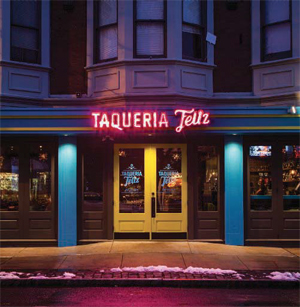
(Continued from page 2)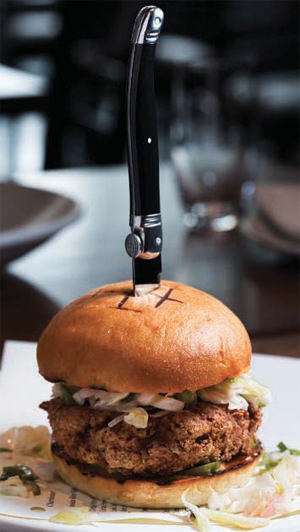
He launched the first Bigalora in 2010, encouraging a festive atmosphere with giant Farrah Fawcet posters, cowskin rugs, clear chairs, multiple beers on taps and imported wood-fired pizza ovens. Initially the focus was on pizza, but DelSignore quickly revised the menu after seeing that his audience wanted more variety. Today there are three stores in suburban Detroit and Ann Arbor; DelSignore is eyeing two more Michigan locations and possible expansion beyond.
Since venturing into casual terrain, DelSignore has faced new labor and food cost challenges. Hiring for a casual restaurant is more difficult than at a more upscale operation. “Because fine dining tips are bigger, it’s easier to maintain a high-quality staff and managers because there’s more money to split,” he says. And, like many fine dining chefs, he refuses to skimp on the ingredients and continues to make items like sauces, breads and gelatos in house, which pushes up the food costs. “People think casual food should be cheap, but when you do it the way we do, it isn’t.”
Takashi Yagahashi, chef/owner of the Michelin-starred Takashi in Chicago, is about to open his second Slurping Turtle casual eatery (the latest is in Ann Arbor, MI). He likes running both concepts, but he also questions the assumption that casual restaurants are cash cows compared to their upscale siblings. “A lot of people say fine dining is tough,” he observes. “That’s true: Food costs are higher, labor costs are higher. But when you have a high-end dining room, and you fill it up on a Friday or Saturday night, the profits are very high—at a casual restaurant, not so much.”
Extending a brand
New York City’s Rosa Mexicano revolutionized Mexican restaurants when it opened in 1984. “It was one of the few white tablecloth places that was fun,” says Tom Dillon, president and c.e.o. of the now 15-unit brand. But times and tastes changes, and the company was seeking a way to avoid the “special occasion” label.
“After the economic downturn, people still wanted to go out but didn’t want to commit to a full dining experience. So we put better food in the bar,” says Dillon. In the past year, Rosa Mexicano has launched a series of Cantina Bars throughout their restaurants nationwide. The Cantina Bars depart from their reputation for upscale Mexican cuisine with these festive outdoor concepts in Atlanta, Minneapolis, Boston and Hackensack, NJ, where the menu features pitchers of margaritas, street-style tacos, a Mexico City-style hot dog, pressed sandwiches and the company’s signature guacamole.
Brian Sirhal and Tim Spinner also were looking to broaden their appeal, in this case to a Philadelphia neighborhood known for its younger demographic, when they opened Taqueria Feliz last fall. The new venture offers a simplified menu at slightly lower price points compared to Cantina Feliz and La Calaca Feliz, its more sophisticated cousins. Taqueria celebrates street food—tacos and enchiladas, sub-$20 entrees—and a lively mood.
“It’s a smaller and easier to execute menu,” Sirhal says. “Because it’s streamlined, we can do it with a minimal number of people, then bump up the staff on weekends when it is busier.”
Another winning strategy aimed at the youth market: “We place a strong emphasis on what we do during happy hour,” Sirhal says. Enticements include $3 draft beers, $5 margaritas and deals on food.

